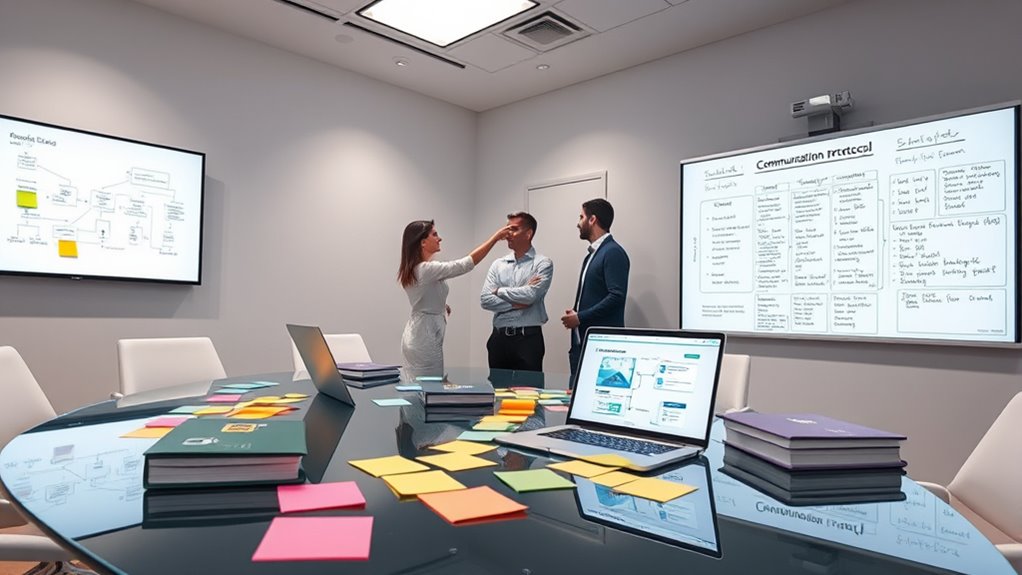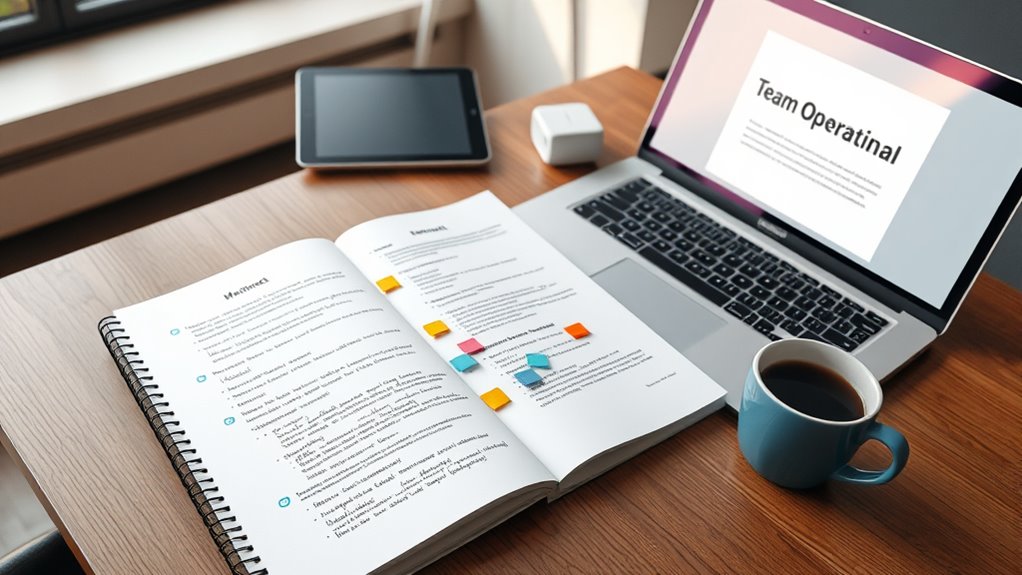To write a team operating manual, start by clarifying its purpose and scope to set clear boundaries. Define each team member’s roles and responsibilities to guarantee accountability. Establish communication protocols and regular meeting schedules to maintain alignment. Detail procedures, workflows, and performance standards to streamline operations. Include policies, guidelines, and review processes to keep everyone informed and compliant. Implement effective distribution and training methods. If you continue exploring, you’ll uncover how to bring clarity and cohesion to your team’s operations.
Key Takeaways
- Define clear team roles, responsibilities, and delegation practices to ensure accountability and streamline workflows.
- Establish communication protocols, meeting schedules, and escalation procedures for effective information flow.
- Map out procedures and workflows using visual tools, setting performance standards and success metrics.
- Include policies, core values, and guidelines, regularly reviewing and updating them for relevance.
- Distribute the manual through multiple channels, provide training, and assign champions to promote understanding and engagement.
Defining the Purpose and Scope of Your Manual

Have you ever wondered why a clear purpose is essential for your team operating manual? The answer lies in aligning your team’s vision with the manual’s scope. Your team vision defines the ultimate goals and values guiding everyone’s actions. When you clearly state the purpose, it provides direction, ensuring the manual covers relevant processes and protocols. The manual scope outlines what areas it will address, preventing scope creep and keeping your team focused. By defining both purpose and scope upfront, you create a solid foundation that clarifies expectations and streamlines onboarding. This clarity helps team members understand why the manual exists and what it aims to achieve, making it easier to follow and implement effectively. Incorporating clear water concepts can also promote transparency and fluidity in team operations.
Outlining Team Roles and Responsibilities

To guarantee your team runs smoothly, you need clear role definitions so everyone knows what they’re responsible for. Delegating responsibilities effectively helps prevent overlaps and gaps. When roles are well-defined, your team can work more efficiently and stay accountable. Incorporating effective delegation practices ensures that each team member’s responsibilities align with their skills and expertise. Additionally, understanding the benefits of eye patches can be useful for teams involved in skincare or wellness industries to better serve client needs. Recognizing how tracking keto diet methods are used can also inspire team members to adopt disciplined routines and improve overall productivity. Furthermore, familiarity with performance tuning strategies can enable team members to optimize workflows and technical processes. Having a thorough understanding of payment processing solutions can further streamline your team’s financial operations and enhance service delivery.
Clear Role Definitions
Why is it essential to define clear roles within your team? When roles are well-defined, everyone understands their responsibilities, which fosters role clarity. This clarity reduces confusion, overlaps, and gaps, ensuring tasks are completed efficiently. Clear role definitions also support accountability measures, making it easier to track who is responsible for each task and hold team members accountable. When everyone knows their specific duties, it encourages ownership and improves overall team performance. Without clear roles, you risk miscommunication and blurred lines of responsibility, which can hinder progress. Take the time to outline each team member’s role precisely, so expectations are transparent. This foundation promotes a cohesive, productive environment where accountability is built into the team’s structure. Additionally, understanding crypto pump and dump schemes can help your team identify potential risks associated with market manipulation and safeguard your investments. Recognizing different cost and budgeting considerations ensures your team manages resources effectively and supports the project’s financial health. Moreover, clarifying personality traits within team members can enhance collaboration by addressing individual strengths and weaknesses. Being aware of asset division laws and strategies can further improve team decision-making and risk assessment in relevant contexts. Also, considering the horsepower of electric dirt bikes can provide insights into performance expectations for team projects involving power specifications.
Responsibility Delegation
Effective responsibility delegation begins by clearly outlining each team member’s roles and responsibilities. This clarity helps prevent conflicts and boosts team motivation, ensuring everyone knows what’s expected. Assign tasks based on strengths and expertise, and communicate these assignments openly. Use a simple table to organize roles:
| Role | Responsibilities | Key Focus |
|---|---|---|
| Project Lead | Oversee progress, conflict resolution | Team motivation |
| Developer | Write code, fix bugs | Quality & deadlines |
| Designer | Create visuals, user experience | Consistency |
This structure keeps responsibilities transparent, minimizes misunderstandings, and encourages accountability. When everyone understands their role, team cohesion improves, and tasks get done efficiently. Clear delegation fosters a positive environment where conflict is managed proactively, maintaining high team motivation. Additionally, understanding the roles helps ensure tasks are aligned with the team’s diverse preferences, improving overall satisfaction and effectiveness. Incorporating role clarity into the delegation process can further enhance team performance and satisfaction by reducing ambiguity and promoting accountability. Furthermore, emphasizing effective communication ensures that team members remain informed and engaged throughout the project lifecycle, which is essential for effective collaboration and team cohesion.
Establishing Communication Protocols

You need clear communication channels so everyone knows where to share updates and ask questions. Setting a regular meeting schedule keeps the team aligned and prevents misunderstandings. By establishing these protocols, you make certain of smooth, effective collaboration at all times. Additionally, defining team roles and responsibilities ensures accountability and clarity within the team. Incorporating privacy policies and transparent data practices fosters trust and compliance among team members. Recognizing the importance of public image management can also help the team navigate external perceptions and maintain professional integrity. Furthermore, understanding screening guidelines can aid in making informed decisions about health initiatives and team awareness campaigns. Incorporating ice cream recipes into team-building activities can also enhance camaraderie and creativity among members.
Clear Communication Channels
Establishing clear communication protocols is essential for ensuring that everyone on the team stays informed and aligned. When you set up effective channels, you create a foundation for trust and efficiency. Use feedback loops to confirm understanding and catch issues early. Define escalation procedures to handle urgent matters swiftly and prevent confusion. Clear channels reduce miscommunication and keep everyone accountable. To evoke emotion, consider these key points:
- Feel confident knowing your voice is heard through structured feedback loops.
- Trust that urgent concerns will be addressed promptly thanks to clear escalation procedures.
- Experience seamless teamwork, knowing communication flows smoothly.
- Feel empowered with transparent protocols that foster collaboration and respect.
- Implementing AI security measures within communication channels can further enhance threat detection and protect sensitive information.
These elements transform your team into a cohesive, motivated unit, ready to tackle any challenge.
Regular Meeting Schedules
To keep your team aligned and engaged, setting a consistent meeting schedule is essential. Determine the right meeting frequency that suits your team’s workload and project needs, whether daily, weekly, or biweekly. Regular meetings help maintain momentum and ensure everyone stays informed. When planning each session, focus on clear agenda setting to maximize productivity; share the agenda beforehand so participants can prepare. Keep meetings purposeful and on track by sticking to the agenda and allocating time wisely. Consistent scheduling fosters accountability and allows team members to plan around meetings. Adjust the frequency as needed based on project phases or team feedback. Establishing effective communication protocols ensures that information flows smoothly and everyone remains on the same page. Ultimately, a well-established meeting routine keeps communication flowing smoothly and supports your team’s ongoing collaboration.
Detailing Procedures and Workflows

Detailing procedures and workflows is essential for ensuring team members understand their tasks and can execute them consistently. Clear workflows boost team motivation by creating a sense of purpose and confidence. When everyone knows their role, conflicts diminish because misunderstandings are minimized. To achieve this, consider these key steps:
- Map out each process step-by-step, highlighting responsibilities.
- Create visual diagrams to clarify complex workflows.
- Include guidelines for handling common conflicts quickly and fairly.
- Regularly review and update procedures to adapt to changes.
Setting Expectations and Performance Standards

Once you’ve mapped out procedures and workflows, the next step is to set clear expectations and performance standards. Clearly define what success looks like for each role, so team members understand their responsibilities and goals. When expectations are transparent, team motivation increases because everyone knows how their work contributes to the overall success. Establish measurable standards to track progress and provide regular feedback. This helps prevent misunderstandings and fosters accountability. If conflicts arise, having these standards helps you resolve issues objectively by referring back to agreed-upon benchmarks. Setting clear expectations not only keeps everyone aligned but also creates an environment where team members feel confident and motivated to achieve their best performance.
Incorporating Policies and Guidelines

How do you guarantee your team operates consistently and ethically? Incorporating clear policies and guidelines is essential. These serve as the backbone for team collaboration, ensuring everyone understands expectations and behaviors. Well-crafted policies foster trust, reduce misunderstandings, and streamline conflict resolution. When team members know the boundaries, they feel secure and motivated to contribute. To make this effective, consider these key points:
- Define core values that reflect your team’s ethical standards.
- Establish clear procedures for common situations and conflicts.
- Communicate policies openly to promote transparency and buy-in.
- Review and reinforce policies regularly to adapt to evolving needs.
Reviewing and Updating the Manual Regularly

Regularly reviewing and updating your team operating manual guarantees it remains relevant and effective as your team evolves. Incorporate feedback loops to gather insights from team members about what works and what doesn’t. This continuous improvement process helps identify gaps and adapt procedures accordingly. Schedule periodic reviews, such as quarterly or biannually, to ensure the manual reflects current practices. Use a simple table to track updates:
| Review Date | Changes Made |
|---|---|
| Jan 2024 | Clarified communication protocols |
| Apr 2024 | Updated role responsibilities |
| Jul 2024 | Added new safety procedures |
| Oct 2024 | Refined project management steps |
Distributing and Training Your Team on the Manual

After updating your team operating manual, the next step is ensuring everyone knows where to find it and understands how to use it effectively. This boosts team engagement and improves manual accessibility. To do this:
- Share the manual through multiple channels—email, shared drives, and team meetings—to reach everyone.
- Host focused training sessions to walk through key sections, encouraging questions and feedback.
- Reinforce the manual’s importance regularly, making it clear it’s a living document for everyone’s benefit.
- Assign champions or go-to persons who can assist with questions, fostering a culture of continuous learning.
Frequently Asked Questions
How Often Should the Manual Be Formally Reviewed and Revised?
You should review your manual at least annually to guarantee it stays current and relevant. Regular manual updates help address changes in team structure, processes, or policies. If your team experiences frequent shifts, consider more frequent reviews, such as quarterly. Staying proactive with your review frequency ensures everyone remains aligned, reducing confusion and improving efficiency. Make it a routine to evaluate and revise your manual consistently for the best team performance.
What Tools Are Best for Digital Manual Distribution and Updates?
Think of your manual like a living document, evolving with your team. Use cloud storage tools like Google Drive or Dropbox for easy access and real-time updates. Version control features guarantee everyone works on the latest version, avoiding confusion. I once saw a team save hours by switching to cloud tools, illustrating how seamless distribution and updates keep everyone aligned and efficient. These tools make manual management simple and responsive.
How Can Team Members Provide Feedback on the Manual’s Effectiveness?
You can encourage team members to provide feedback by setting up regular manual evaluations and inviting peer feedback through surveys or dedicated discussion channels. Make it easy for them to share their thoughts on clarity, usefulness, and gaps. Actively listen and respond to their input, showing that their feedback shapes the manual’s improvements. This ongoing process guarantees the manual remains relevant and effective for everyone.
What Are Common Challenges in Implementing a Team Manual?
You might face challenges like resistance to change management, which can hinder adoption of the team manual. Employees may feel disengaged if they’re not involved in the process or see little value, impacting employee engagement. To overcome this, communicate clearly, involve team members early, and emphasize the manual’s benefits. Regularly gather feedback and adjust your approach to foster buy-in and smooth implementation.
How Do We Ensure Compliance With Policies Outlined in the Manual?
You guarantee compliance with policies by implementing effective policy enforcement strategies and regular training programs. Clearly communicate expectations, provide accessible resources, and hold team members accountable through consistent follow-up. Use training programs to reinforce policy understanding and address questions promptly. Regularly review and update policies, and create a culture that values adherence. This proactive approach helps maintain compliance and fosters a disciplined, aligned team environment.
Conclusion
Creating a clear team operating manual boosts efficiency and reduces misunderstandings. Did you know teams with well-documented procedures are 30% more productive? By defining roles, communication, and expectations, you set your team up for success. Regular updates keep everyone aligned and engaged. Make sure to distribute and train your team thoroughly. A solid manual isn’t just a document—it’s your roadmap to smoother, stronger teamwork and better results.









